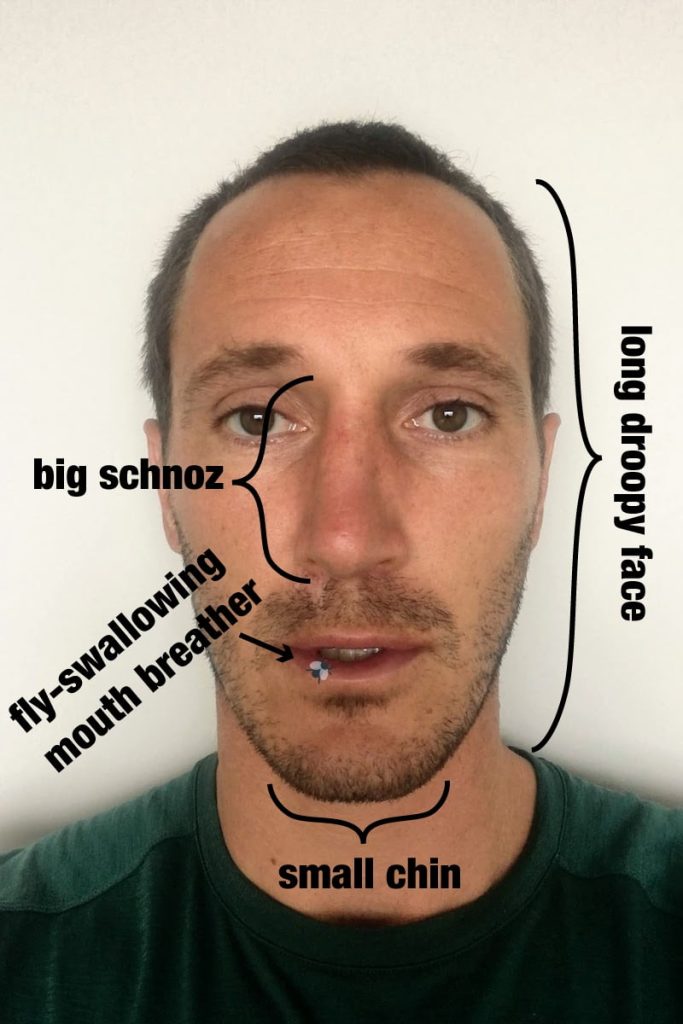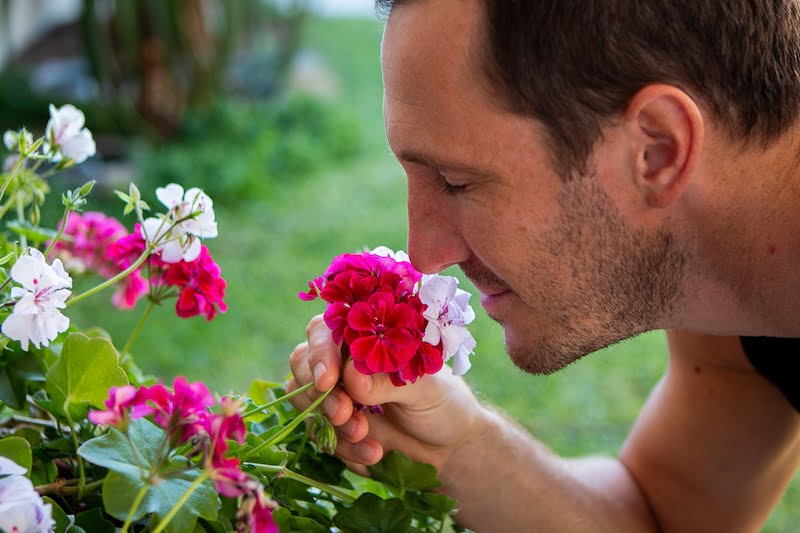Key Points
- Mouth breathing is bad for your well-being and appearance. You can’t do much about the latter, but the former is fixable.
- Learning to nose breathe is like yoga: it feels uncomfortable at first but if you breathe deep and easy you’ll open up.
- If a narrow-nostril-ed, broken-nosed, allergy-suffering bozo like me can quit mouth beathing, you can, too.
Why the Long Face?
I stopped mouth breathing and started nose breathing the day after Kim and I got married.
It had nothing to do with the nuptials or my new wife, though. No, it was all thanks to a podcast episode we listened to on our drive home:
How Changing Your Breathing Can Change Your Life.
In it, the guest, author James Nestor, caught our attention with this:
“Scientists can tell if someone has been breathing through their mouth through their youth because of the way in which their face has grown. And what that means is it’s a longer face, it’s a droopier face, the chin is recessed, so you don’t have this big powerful chin….”
Kim turned to look at me…
I double-checked my face in the car mirror…
Yep.
Nestor had described me!
I’m a long-and-droopy-faced, small-chinned, fly-swallowing mouth breather:

I turned up the volume and slowed the podcast playback from 1.75x to 1.25x speed. And what Nestor went on to explain changed my perspective and gave me hope.
It was too late to fix my facial structure, but it wasn’t too late to stop mouth breathing and become a nose breather.
My Breath-Changing Story
Part 1: Seal the Deal

Please don’t cause (more) brain damage.
That same night after Nestor took my (mouth) breath away, I followed his advice and taped my trap shut while I slept.
Kim thought taping my mouth was ridiculous. But since we were now married, that didn’t bother me.
I was nervous, though.
I got light-headed when I tried nose breathing while watching TV. How would I make it eight hours straight?
Making matters more worrisome, my long and narrow nasal passageway was, as usual, partially blocked with snot. What if it got fully blocked while I was sleeping?
I trusted my subconscious would force my mouth open or wake me up before I suffocated. But what if I got enough oxygen to survive, but not enough to keep all my brain cells alive? Would I wake up irrevocably brain-damaged?
Somehow, despite these worries, I managed to fall asleep with my mouth taped shut.
And the next morning, I still had enough brain cells left to write this in my lifelog:
“6:45 Up. 1st night sleeping with tape on mouth. Just small piece of masking tape up/down over mouth was enough. Stayed on all night. I woke up a couple of times feeling weird. A couple of times I felt great, like extra fresh. Will have to continue through the week”
A promising start!
A Blistering Pace
I didn’t make it through a full week of overnight mouth taping.
After my sixth straight taped-mouth slumber, here’s what I wrote.
“7:07 up. tape didn’t work. started hurting. I now have small wounds on my lips.”
The masking tape I was using had given my sensitive lips a cold-sore-like blister. And the wound ballooned that day, so I was forced to abort my mouth taping experiment to give my lips time to recover.
Meanwhile, I ponied up and bought some lip-safe medical tape.
I also plowed through both Nestor’s book, Breath, and The Oxygen Advantage by Patrick McKeown.
In the latter, I found a helpful tip:
Tape your mouth horizontally rather than vertically.
That way, the little corners of torn tape don’t tickle you as they flutter in the breeze of your nose breathing.
Fewer Busted Brain Cells
With the right tape on my mouth the right way and a few days of getting used to the feeling, breathing through my nose overnight became remarkably no big deal.
I thought I was free and clear…
…until, one evening, I drank more than I should.
From my Oura sleep tracking ring, I already knew that booze screws with sleep quality big time. It raises my resting heart rate from around 42 to 52 and destroys any trace of deep sleep.
But what I didn’t realize before, because I was a mouth breather, was this:
High blood alcohol constricts my nasal airway.
Because of this, that night’s semi-drunken slumber was the closest I came to ripping the tape off to return to mouth breathing.
But I kept it on. And I got one reward for each nostril:
- I felt less hungover than usual. Breathing through your mouth is dehydrating, which makes hangovers worse. It also makes you more likely to wake up thirsty in the middle of night, disrupting your sleep and further aggravating the situation. Nose breathing minimizes both.
- It gave me another reason not to drink so much. I’ll never become a teetotaler, but anti-alcohol evidence is piling up and making the pro/con teeter-totter is tipping me toward never wanting to get more than tipsy.
Also, contrary to one of the widely-reported benefits of nose breathing instead of mouth breathing, Kim sadly discovered that people can still snore when their mouths are taped.
Part 2: Expand Your Nose’s Comfort Zone

HIIT-ing My Nose Hard
Breathing through your nose while sleeping is one thing. Keeping it up throughout the oxygen-demanding movements of the day is another.
So, four weeks after my first night of mouth taping, I felt confident enough to further push the edges of my long and narrow nose’s comfort zone.
Similar to Nestor’s nasal training stories from his book and in line with McKeown’s breathing exercise recommendations, I set out to nose breathe pant my way through one of my “favorite” quick HIIT workouts:
- Run as fast as I can for one minute.
- Rest for one minute.
- Repeat ten times.
If I could do so without passing out, I figured not mouth breathing the rest of the day would be a cinch.
To the Verge of Bursting
Early on in my nasal HIIT, I felt fine. Great, even.
As I’d learned from Nestor and McKeown, this may have been partly because breathing through your nose releases more nitric oxide than mouth breathing, which relaxes and widens your blood vessels.
So my juices were flowing better than ever…
…until, in round three of ten.
Then the amount oxygen in my blood, not the flow of it, became my limiting factor. I started seeing stars and my eyes bulged from the pressure of trying to vacuum air through my nose.
My comfort zone was swelling outward!
But my nostrils were caving in.
In a phenomenon I hadn’t come across in any of my research, my nasal cavities collapsed in on themselves like crappy plastic straws when you suck hard on a too-thick milkshake.
To avoid fainting, I forced myself to take long, controlled breaths.
It helped, but didn’t fully do the trick. So I also had to slow down a bit and cheat with a couple of desperate mouth gulps after each interval.
But, let me tell you, breathing through my nose while walking home afterward felt like a relief! And it’s a steep uphill walk.
To think, less than a month ago, simply nose breathing my way through an episode of Money Heist made me feel faint.
What an improvement!
Part 3: Treat Your Overbreathing Problem
Breathing Diabetes
Of all the insights I got from Breath and The Oxygen Advantage, this one stuck with me the most:
“Just as we’ve become a culture of overeaters, we’ve also become a culture of overbreathers.”
Mouth breathing, I learned, oversaturates your blood with oxygen like chugging a Mountain Dew does with sugar. And more oxygen means proportionally less carbon dioxide.
So what? CO2’s just our exhaust, right?
Not exactly.
The level of CO2 in your blood, not oxygen, is what your brain uses to gauge when it needs to breathe. And if you constantly guzzle Big Gulps of oxygen, your brain gets used to this new (im-)balance. You become more sensitive to CO2 and more greedy for oxygen.
This starts a vicious cycle similar to insulin resistance:
- When a regular mouth breath feels insufficient, you take bigger and more frequent swigs.
- This increases your CO2 intolerance.
- So you breathe more and deeper.
And so goes the spiral until getting off your couch to grab a can of Mountain Dew has you gulping for air.
This overbreathing, like overeating, can lead to nasty knock-on effects:
- Weight gain
- Poor sleep and lethargy
- Asthma
- Erectile dysfunction
- Bad breath, cavities, and gum disease
- Compromised immune system
- A long, narrow face with a small jaw that requires braces
CO2 Tolerance Training
Fortunately for me, I’m a lifelong athlete who invents SHIIT (super high-intensity interval training) workouts with names like “pant-athlon” for fun, so the symptoms of my breathing diabetes, a.k.a. CO2 intolerance, weren’t that serious.
But, because of my mouth breathing, I wasn’t reaching my athletic potential.
So I added two easy-to-try-at-home, CO2 tolerance training exercises from The Oxygen Advantage to my regime:
Exercise #1: BOLT-ing
BOLT stands for body oxygen level test.
Here’s how you do it:
- Pick a moment when you’ve been resting for ten minutes.
- Take a normal breath in and out of your nose.
- Pinch your nose closed.
- Time how long it takes until you feel your brain telling you it’s time to breathe again—e.g., a need to swallow, constriction of your airways, or involuntary contractions of breathing muscles in your abdomen or throat.
- As soon as you feel one of these cues, stop your timer, release your nose pinch, and get back to breathing calmly. If you need to take a big breath, you were holding too long.
On my first BOLT attempt in late September, I could barely last more than 20 seconds. That’s a long way from the 40-seconds that McKeown says should be easy for an athlete.
So I kept BOLT-ing.
I did it every day as soon as I woke up. And by the end of the year, I regularly cracked the 40-second barrier.
My CO2 tolerance was at a healthy level! I could comfortably sip oxygen through my nose rather than gulp it through my mouth.
In addition to feeling fitter than ever because of it, I also discovered two unadvertised benefits to first-thing-in-the-morning BOLTs:
- Wake-er upper. Holding my breath to do my BOLT gave me a bolt of energy that got me out of bed quicker, and wasting less time dazedly dicking around on my phone.
- Low-tech sleep tracker. My BOLT seemed to be closely correlated to the quality of my sleep. It was miserable the mornings after a night of drinking, not stellar if I woke up to an alarm, and best when I was well-rested.
Exercise #2: Nose Unblocking
For this CO2 tolerance training exercise:
- Start the same way as with the BOLT test—by doing a normal breath out and pinching your nose shut.
- Walk as many paces as you feel comfortable.
- Unpinch and breath at the point where you can return to steady breathing within two to three breaths. Start easy.
- Continue walking for one or two minutes while breathing easily through your nose.
- Repeat for a total of six breath holds, steadily increasing your number of paces each time.
McKeown writes, “When you are able to walk a total of 80 paces with the breath held, your nose will remain decongested.”
At first, my score on this test was even worse than for the BOLT: I maxed out at 32 paces. But within a couple of months of training, I increased it to 60.
I also got a lot of weird looks from people who crossed my path. Maybe they thought I was pinching my nose to reduce the risk of contracting COVID from them.
Even though I never made it to 80 paces, this nose unblocking exercise lived up to its name. The snot that used to clog my nostrils all the time disappeared for good.
I’d become a full-fledged, CO2-tolerant nose breather.

One Year Later: A Fresh Breath
Just last week, Kim and I celebrated our first anniversary. And the day after, I celebrated a personal milestone:
One year of no longer being a mouth breather.
I stopped with the exercises (except taping my mouth) once nose breathing became an unconscious habit, but I remain more conscious than ever of my breathing. As the mindfulness mob makes sure we remember, that’s a good thing.
In addition to the benefits of nose breathing I’ve mentioned and that you can read more about in Breath and The Oxygen Advantage, here are some I experienced first hand:
- Slightly less fat. I didn’t do a DEXA scan before and after to measure, but I could visibly see that the small amount of fat I had on my belly was even smaller than before.
- More relaxed. While, I’m very low on the stress spectrum most of the time, I’m not when playing sports—especially ones I suck at, like beach volleyball. Focusing on nose breathing helps me recenter, refocus, relax, and suck less. Chewing gum helps with this because it makes falling back to mouth breathing more difficult.
- Hay fever-free. For the first time since I was a kid, I didn’t suffer the slightest hint of seasonal allergies this spring.
- Better smelling. I still smell bad, but my sense of smell seems to have improved. Kim’s dad even noticed. He caught me smelling some flowers on his patio, which I hadn’t done before.
Long story short, stopping mouth breathing and starting nose breathing has been a game-changer.
My next order of business?
Making sure our recently-born son, Zac, doesn’t follow his dad’s mouth breathing footsteps.
I don’t want him to become a long-and-narrow-faced, braces-needing, overbreather.
Tips for Aspiring Nose Breathers
1. Tape your mouth.
Like stapling your stomach to lose weight, it works. The difference is even a moron can perform the mouth-taping operation at home on themselves.
It’s low risk, low effort, and high reward. I can’t think of many life “hacks” that meet those criteria.
When taping your mouth:
- Tape horizontally, i.e. so the straight edges of the tape go along your lips.
- Use only an inch-long piece. That’s all you need. That way, if you sneeze, the air has an emergency outlet protecting your brain from exploding.
- Use medical tape. Any kind you can find at a pharmacy. Or if you don’t want to go to the shops and want to support my blog, get this 3M tape from Amazon.
- Tape loosely. Give your lips a little bit of leeway. I find it’s most comfortable if I tape my mouth when my lips are barely grazing.
2. Read up on the biology and benefits.
As was the case with me getting into fasting, gathering a rough understanding of the benefits of nose breathing over mouth breathing and why its better for you gave me more motivation to keep it up.
It also made my transition smoother by learning and reapplying best practices.
I recommend both these books, in this order:
3. Push yourself.
Taping your mouth at night is a good start but to become a full-fledged member of the Noble Nasal Respirator’s Society and reap all the benefits, you’ll have to invest a little bit more.
- Don’t take nights off. You may be tempted, as I was, to take a night off from mouth taping when you have a stuffy nose or constricted nasal airways from excessive alcohol. Don’t. The first minutes—half an hour, even—will be uncomfortable. But if you persevere you’ll reap the real benefits and become a true believer.
- Train during the day, too. I gave you the steps for the BOLT and nose unblocking exercises in my story above. They take no time, just the effort to remember to do them. For a disciplined approach, try making a 30-day challenge out of them to see how far you can progress on either or both.
- Train while you’re training. A trick I learned from Michael Easter, author of the 2021 Unrutty Award-winning book, The Comfort Crisis, is to go for a walk/jog/run with a mouthful of water.
Here’s to Shutting Your Mouth More Often
“Bon courage” is the French way to say “good luck” when luck is not involved. That’s what I wish for you and your mission to stop mouth breathing and start nose breathing.
Please leave any questions, tips, or experiences of your own in the comments.
And if you enjoyed this post, you might like these, too:
About the author
👋 I'm Chris. Everything you read on TheZag.com is my fault. This site is like a gym for your comfort zone, full of challenges to make your status quo sexier. Join my 'Consider This' newsletter for a fun new challenge every 10 days. Try it!
2 responses to “How to Stop Mouth Breathing and Become a Nose Breather”
-

Dude so funny and classic. I am right at the beginning of this nose breathing journey and started the James Nester book a couple days ago and totally obsessing about trying to conquer mouth breathing. I used to have a deviated septum and had surgery for it last year and tried the nose breathing thing a couple times but never took it real serious.
Nice article and good info!
-

A fellow de-deviated septum-ite looking to relearn to nose breathe! All the best with your training. Hope you have as much fun with it as I did.
-





Leave a Comment